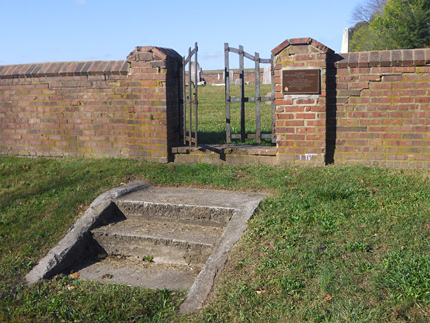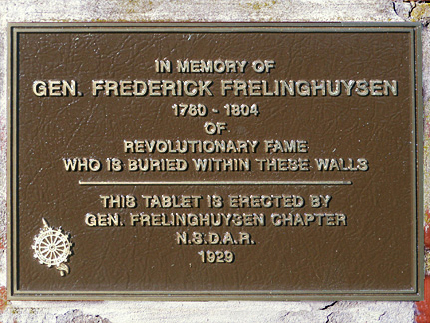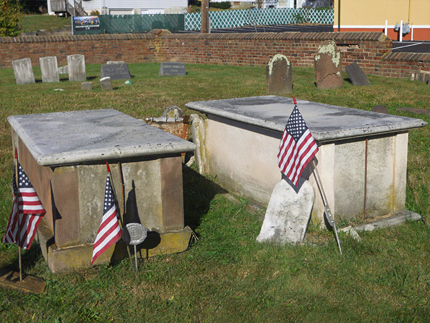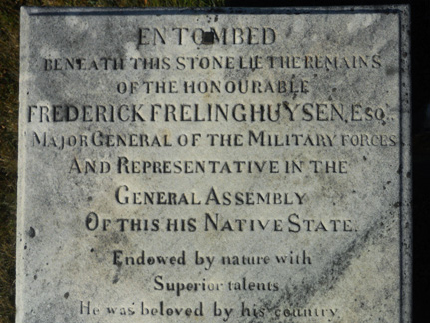





Van Nest Burying Ground
Millstone River Rd. and Schmidt St.
Map / Directions to the Van Nest Burying Ground
The Van Nest Burying Ground contains the grave of Revolutionary War officer Frederick Frelinghuysen (April 13, 1753 - April 13, 1804). He held the rank of Colonel during the Revolutionary War. He would eventually rise to the rank of Major General, when he was commissioned as such by President Washington in 1794 during the Whiskey Rebellion.
Frelinghuysen was also active politically during the founding era. He served in the Continental Congress in 1779, and in the convention that ratified the United States Constitution in 1787. He was elected to a United States senator from New Jersey in 1792; however, he did not serve out his full six-year term. He resigned from the Senate November 12, 1796. [1]
In addition to his military and political roles, Frelinghuysen played a notable part in the beginning of Queen's College (now known as Rutgers University). In November 1771, when the first classes of Queen's College were held in a former New Brunswick tavern known as the "Sign of the Red Lion," Frelinghuysen, who was himself a graduate of Princeton University, served as the first tutor. There is now a plaque to commemorate this at the site of that building at Albany and Neilson Streets in New Brunswick. [2]
Frelinghuysen and his son (also named Frederick) are buried next to each other with elaborate table gravestones.
The text of General Frelinghuysen's table stone reads: [3]
"Entombed beneath this stone lie the remains of the honourable Frederick Frelinghuysen, Esq., Major General of the military forces and representative in the General Assembly of this his native state.
"Endowed by nature with superior talents, he was beloved by his country. From his youth he was entrusted with her most important concerns until his death. He never disappointed her hopes. At the bar he was eloquent, in the Senate he was wise, in the field he was brave. Candid, generous and just, he was ardent in his friendships, constant to his friends. The patron and protector of his honorable merit. He gave his hand to the young, his counsel to the middle aged, his support to him that was feeble in years.
"To perpetuate his memory, his children have raised this monument, a frail memorial of their veneration to his virtues and of their grief and their loss of so excellent a father. He died on the 13th of April 1804, aged 51 years."
A plaque at the entrance of the cemetery mistakenly states that General Frelinghuysen was born in 1760. He was actually born in 1753 [4] at the Old Dutch Parsonage in Somerville.

1. ^ Biographical Dictionary of the United States Congress
2. ^ A Historical Sketch of Rutgers University by Rutgers University Archivist Thomas J. Frusciano, available to be read on the Rutgers University Libraries website
and a plaque on the corner of Albany and Neilson Streets in New Brunswick erected by the Society of Colonial Wars in the State of New Jersey, November 20123. ^ Text of Frelinghuysen's table gravestone
4. ^ The plaque at the entrance with the 1760 birth year was placed by the Gen. Frelinghuysen Chapter of the N.S.D.A.R. in 1929.
1753 is given as his birth year in other sources, including the Biographical Dictionary of the United States Congress. As quoted in the entry above, his gravestone states, "He died on the 13th of April 1804, aged 51 years," which would also fit 1753 as the year of his birth.
I accept the 1753 date not only because it appears more often, but because it fits the rest of the chronology:
Frelinghuysen became the first tutor for Queen's College in 1771, when he was already a graduate of Princeton. Putting his birth in 1760 would mean that he would have only been 11 when this happened.
Accepting the 1753 date puts him at a more realistic 18 years old in 1771.
Note that the system of schooling and college was much different in the eighteenth century, so graduating from college by the age of 18 would not be unusual at that time.